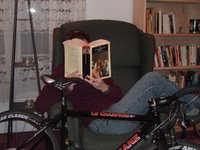I'm taking a break from summing up my year (more on that to come though!) to write about Richard Holmes's book Footsteps: Adventures of a Romantic Biographer, of which I have now read about 35 pages, and 35 captivating pages they are. I've found a new quotation for my blog (see above) and have become convinced I need to read Robert Louis Stevenson's Travels with a Donkey in the Cevennes. Holmes is following in Stevenson's footsteps and writing about his travels and also about his devotion to Stevenson and to the genre of biography.
In one scene, Holmes describes how he has become so obsessed with Stevenson, he feels that Stevenson is actually there, and as Holmes walks through towns and looks at faces, he searches for Stevenson's likeness. But then he experiences a disappointment: although he has tried to follow his footsteps exactly, he realizes that the bridge on which he crossed a river is not the one Stevenson had used; instead, he finds an old crumbling bridge a little further upstream that marks his path. His response is powerful: "The discovery put me in the blackest gloom. It was stupid, but I was almost tearful."
What he realizes is that he cannot follow in Stevenson's literal footsteps -- the route has changed over the course of the hundred or so years that separate them -- but also that he cannot find Stevenson himself; he cannot perfectly follow the traces of his life. A biographer can only approximate the life, can only follow in the subject's footsteps at a distance; there is always a gap between biographer and subject:Even in imagination the gap was there. It had to be recognized; it was no good pretending. You could not play-act into the past, you could not turn it into a game of make-believe. There had to be another way. Somehow you had to produce the living effect, while remaining true to the dead fact. The adult distance -- the critical distance, the historical distance -- had to be maintained. You stood at the end of the broken bridge and looked across carefully, objectively, into the unattainable past on the other side. You brought it alive, brought it back, by other sorts of skills and crafts and sensible magic....
I'm a sucker for travel metaphors and I like this one -- to write a biography is to travel along with the subject, following in that person's footsteps on his or her life's journey. Holmes is physically acting out his life's work, covering the landscape Stevenson had crossed, attempting to see the things Stevenson's saw, but seeking Stevenson's mental and emotional landscape as well as his geographical one. And he both succeeds and fails in this attempt -- time and change create a space between Holmes and Stevenson that can't be bridged. I like that it is a journey that teaches him this lesson and that he has turned this lesson into a book; Footsteps is a travel book in two senses (but all travel books are this, aren't they?), physical travel across a landscape and an intellectual and emotional journey as well.
... it was the first time that I caught an inkling of what a process (indeed an entire vocation) called "biography" really means. I had never thought about it before. "Biography" meant a book about someone's life. Only, for me, it was to become a kind of pursuit, a tracking of the physical trail of someone's path through the past, a following of footsteps. You would never catch them; no, you would never quite catch them. But maybe, if you were lucky, you might write about the pursuit of that fleeting figure in such a way as to bring it alive in the present.
Wednesday, December 20, 2006
Footsteps
Posted by
Rebecca H.
at
8:18 AM
![]()
Labels: Books, Nonfiction
Subscribe to:
Comment Feed (RSS)



|